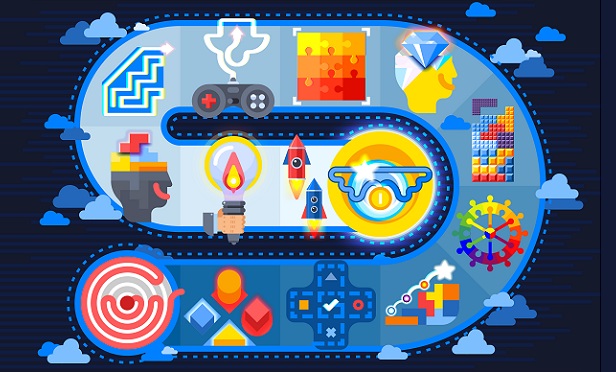 Everyone, itseems, enjoys playing games—and HR professionals can leverage thatsense of enjoyment for better assessment results. (Image:Shutterstock)
Everyone, itseems, enjoys playing games—and HR professionals can leverage thatsense of enjoyment for better assessment results. (Image:Shutterstock)
Work is work—and there's no room for “play” at work, right?While the workplace is meant for serious effort, some of the mostproductive results can come from activities that are perceived as“fun.” That approach most definitely has a place in the hiringprocess.
|As any HR professional knows, candidates are typically stressedby the hiring experience. Given their desire to bechosen for a position, it's difficult during the selection processfor an interviewer to understand who candidates are as individuals,when all those candidates want to share is what they think theinterviewer wants to hear.
|One of the best ways to get someone to let their guard down andreveal their true selves is by playing a game. Anyone with children(or with firsthand experience in the subject—which, for those underthe age of 35, is just about everyone) is intimately aware of howvideo games have permeated our culture. The global games marketgrew to $160.5 billion in 2018, according to game and esportsanalytics company Newzoo, and continues to expand at a 9.3 percentCAGR. Everyone, it seems, enjoys playing games—and HR professionalscan leverage that sense of enjoyment for better assessmentresults.
|In the 2017 Deloitte Global Human Capital Trendsstudy, only 6 percent of HR respondents rated their ability to usegames and simulations to assess potential candidates as “strong.”Yet turning assessment tests, and by assessment, we're referring topersonality testing, situational judgment tests, realistic jobpreviews and the like, into games can have real advantages:
- Stimulating the brain and get more effectiveresults. Gamification can create a more engagingenvironment that enables users to retain information better.Academic studies show that student retention ofinformation is better in a gaming environment. Another study showed that gamification increased theretention of knowledge for employees taking online training.
- Increasing long-term engagement. Gamification,if done appropriately using techniques like leaderboards andlonger-term point systems, encourages completion of an extendedtask.
- Encouraging faster completion. Numerousstudies show that gamification can reduce the time it takes tocomplete a given task.
- Generally more inclusive. In today's worldwhere inclusivity is essential, gamification has been shown to bemore effective in testing and engaging individuals who haveAttention Deficit Hyperactive Disorder (ADHD) and its relatedconditions.
- Increased usability for targeted age groups.Not surprisingly, games generally have a profoundly positive impacton millennials; researchers have even coined the term “recruitainment” to explain the benefits. Butnearly everyone prefers doing tasks in a gamingenvironment—one study at a Fortune 500 firm found thatengagement on gamified platforms resulted in a 94 percent adoptionrate.
- Increased skills transferability. Games helpindividuals to learn a skill that can be used in differentprofessional environments. Tests show that individuals can learnboth hard and soft skills in a game environment, and then applythose skills in the real world.
Nearly any assessment test can become more engaging andeffective through gamification. Standard Myers-Briggs testing cannot only be more enjoyable, and more revealing and comprehensive,when simple gaming techniques like dragging boxes or linking iconsare used. Animations can transform situational testing to provideadditional interest and involvement. Emotional intelligence can beaccurately measured through games that ask “players” to interpretfaces and scenarios.
|Growth-stage companies and multinational corporations alike areusing gamification to improve their hiring practices. One majorconsumer products company uses a series of games to measure problemsolving capabilities, communication skills, and personality traits.The games, available online or via table and smartphone, are usedin the early stages of the screening process; those selected by theprocess move on to video interviews. All participants receivepersonalized results showing how they did.
|The power of gamification to improve and accelerate theassessment process is something virtually any employer shouldconsider. Integrating it into hiring practices typically involvespartnership with an outsourcing vendor who specializes inassessment game design. Basic assessment tests can be licensed “offthe shelf,” although more advanced or trait-specific tests mayrequire the creation of customized solutions.
|Before adopting a gamified assessment tool, HR workers shouldconsider how the tool fits into the overall hiring process. Does itmap well into the organization's model for measuring desirableworker traits? Does the process fit smoothly into the candidateexperience? Does it seem incongruent in any way?
|It's equally important to confirm the science behind theplatform. A gamified assessment tool needs to go through the samevalidity and reliability testing as any regular cognitiveassessment test. Results of the assessment must also be insightful;it's nice to know that a candidate is optimistic, for example, butwithout further depth you may not be getting a good return oninvestment.
|Finally, don't forget the fun aspect. Creating an enjoyableassessment experience isn't easy, and without this importantattribute, the other benefits may not accrue. Have employees tryout the game, and make adjustments if the process is boring,confusing, or frustrating.
|Re-interpreting the hiring process through gamification canlower barriers, reduce stress, and improve outcomes. It canactually help to build a company's reputation as an enjoyable andrewarding place to work. Games are increasingly a part of ourculture—and as such they can be a valuable strategy for deeperunderstanding. Apply games carefully, as part of a well-consideredhiring process, and everyone can come out a winner—employer andcandidate alike.
Read more:
- Corporate trainers look to gamification to train Gen Zworkers
- Gamification growing in wellness
- The gamification of employeebenefits
Franz Gilbert is VP of SolutionProvider Programs at BersinTM, Deloitte ConsultingLLP. As used inthis document, “Deloitte” means Deloitte Consulting LLP, asubsidiary of Deloitte LLP. Please see www.deloitte.com/us/about fora detailed description of their legal structure.
Complete your profile to continue reading and get FREE access to BenefitsPRO, part of your ALM digital membership.
Your access to unlimited BenefitsPRO content isn’t changing.
Once you are an ALM digital member, you’ll receive:
- Critical BenefitsPRO information including cutting edge post-reform success strategies, access to educational webcasts and videos, resources from industry leaders, and informative Newsletters.
- Exclusive discounts on ALM, BenefitsPRO magazine and BenefitsPRO.com events
- Access to other award-winning ALM websites including ThinkAdvisor.com and Law.com
Already have an account? Sign In
© 2024 ALM Global, LLC, All Rights Reserved. Request academic re-use from www.copyright.com. All other uses, submit a request to [email protected]. For more information visit Asset & Logo Licensing.








